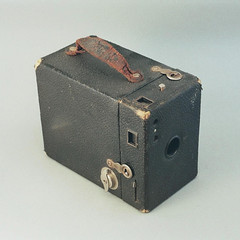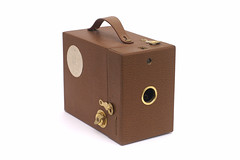Difference between revisions of "Hawk-eye No. 2"
m |
Hanskerensky (talk | contribs) (Added link to user manual page) |
||
| (42 intermediate revisions by 12 users not shown) | |||
| Line 1: | Line 1: | ||
| − | + | {{Flickr_image | |
| − | + | |image_source= http://www.flickr.com/photos/50678983@N00/168880903/in/pool-camerawiki | |
| − | + | |image= http://static.flickr.com/72/168880903_cd3577e68f_m.jpg | |
| + | |image_align= right | ||
| + | |image_text= | ||
| + | |image_by= Dries van den Elzen | ||
| + | |image_rights= with permission | ||
| + | }} | ||
| + | __TOC__ | ||
| + | {{br}} | ||
== Origins == | == Origins == | ||
| − | The original Hawk-eye cameras were made by the Boston Camera Co. | + | The original Hawk-eye cameras were box-shaped cameras for 4x5" glass plates, made by the Boston Camera Co. This was absorbed by [[Blair|Blair Camera Co]]. in 1890, who in turn were taken over by [[Kodak|Eastman Kodak]] in 1899.<ref>{{McKeown12}}</ref> |
| − | + | <!-- Kodak numbers referred to film sizes, not sequence of introduction--> | |
| − | |||
== Cardboard and leatherette== | == Cardboard and leatherette== | ||
| − | + | {{Flickr_image | |
| − | + | |image_source= http://www.flickr.com/photos/50678983@N00/168880905/in/pool-camerawiki | |
| − | + | |image= http://static.flickr.com/65/168880905_9be4b730b3_s.jpg | |
| − | + | |image_align= right | |
| − | It uses 120 film to make 6×9 cm | + | |image_text= |
| + | |image_by= Dries van den Elzen | ||
| + | |image_rights= with permission | ||
| + | }} | ||
| + | The '''Hawk-eye No. 2''' was a simple [[box camera]] with no adjustments and inexpensive construction. It has a cardboard body (this can be seen in the worn corners of the camera illustrated above). The body is covered with black leatherette and it has a real leather strap on top. They were made from 1913 onwards, and this particular one was produced in Great Britain (see leatherette imprint). | ||
| + | It uses [[120 film]] to make 6×9 cm pictures. British and American users may have thought of this as 2 ¼ × 3 ¼ inches. | ||
| + | {{br}} | ||
== Viewfinder and lens == | == Viewfinder and lens == | ||
| − | + | The Hawk-eye No. 2 has two viewfinders. Both are small [[brilliant finder]]s, one seen from above and the other from the right side of the camera. The camera uses a simple [[meniscus lens]] behind the shutter. | |
| − | + | ||
| − | + | == Transport and opening the camera == | |
| − | The | ||
| − | + | {|class=plainlinks align=right | |
| + | | | ||
| + | {{Flickr_image | ||
| + | |image_source= http://www.flickr.com/photos/awcam/4085568719/in/pool-camerawiki | ||
| + | |image= http://farm3.static.flickr.com/2477/4085568719_b72c68bb11_s.jpg | ||
| + | |image_align= | ||
| + | |image_text= | ||
| + | |image_by= | ||
| + | |image_rights= | ||
| + | }} | ||
| + | | | ||
| + | {{Flickr_image | ||
| + | |image_source= http://www.flickr.com/photos/50678983@N00/168880906/in/pool-camerawiki | ||
| + | |image= http://static.flickr.com/63/168880906_bb2cf34093_s.jpg | ||
| + | |image_align= | ||
| + | |image_text= | ||
| + | |image_by= | ||
| + | |image_rights= | ||
| + | }} | ||
| + | | | ||
| + | {{Flickr_image | ||
| + | |image_source= http://www.flickr.com/photos/50678983@N00/168880907/in/pool-camerawiki | ||
| + | |image= http://static.flickr.com/73/168880907_4da60202b8_s.jpg | ||
| + | |image_align= | ||
| + | |image_text= | ||
| + | |image_by= | ||
| + | |image_rights= | ||
| + | }} | ||
| + | | | ||
| + | {{Flickr_image | ||
| + | |image_source= http://www.flickr.com/photos/50678983@N00/168880908/in/pool-camerawiki | ||
| + | |image= http://static.flickr.com/51/168880908_911a7ac2b6_s.jpg | ||
| + | |image_align= | ||
| + | |image_text= | ||
| + | |image_by= | ||
| + | |image_rights= | ||
| + | }} | ||
| + | |- | ||
| + | |colspan=4 align="center"|<small>image left by {{image author|AWCam}}, others {{image author|Dries van den Elzen}}. Both:</small> {{with permission}} | ||
| + | |} | ||
| − | + | The silver winding key protruding from the side of the camera is turned in the direction of the arrow to advance the film. Frames are counted via a red window in the back. Opening the camera is less obvious. Even after opening the eye-locks, it does not seem possible to separate the halves of the body. Only after pulling the winding lever outwards will they come apart. | |
| − | |||
| − | |||
| − | |||
| − | |||
| − | |||
| + | An ad placed inside the camera advises you to insist on Kodak [[120 film]], either regular or Verichrome. (The latter was not a color film; it was an improved B&W emulsion introduced by Kodak in 1931<ref>[https://web.archive.org/web/20080627183832/http://www.kodak.com/global/en/corp/historyOfKodak/1930.jhtml History of Kodak: 1930–1959] at the [https://web.archive.org/web/20070312174508/http://www.kodak.com/global/en/corp/historyOfKodak/historyIntro.jhtml Kodak corporate history site] (archived).</ref>, with better sensitivity to green and yellow light.) | ||
== Shutter and aperture == | == Shutter and aperture == | ||
| − | The shutter is of the simple "guillotine" type. It has just one speed | + | The shutter is of the simple "guillotine" type. It has just one speed, which sounds like 1/30s. Two apertures are available through a pull-out strap on the top of the box. This will put openings of different diameters in the pathway of the light. |
| − | |||
| + | == Simpler versions: original Model C and 50th anniversary camera == | ||
| + | {{Flickr_image | ||
| + | |image_source= http://www.flickr.com/photos/awcam/4085472101/in/pool-camerawiki | ||
| + | |image= http://farm3.static.flickr.com/2781/4085472101_fa6305b7f5_m.jpg | ||
| + | |image_align= right | ||
| + | |image_text=British Model C | ||
| + | |image_by= AWCam | ||
| + | |image_rights= with permission | ||
| + | }} | ||
| + | {{Flickr_image | ||
| + | |image_source= http://www.flickr.com/photos/captkodak/271771351/in/pool-camerawiki | ||
| + | |image= http://farm1.static.flickr.com/101/271771351_aee575cbf5_m.jpg | ||
| + | |image_align= right | ||
| + | |image_text=50th anniversary model | ||
| + | |image_by= Steve Harwood | ||
| + | |image_rights= non-commercial | ||
| + | }} | ||
| + | The Hawk-Eye No. 2 model C of 1913 was a simpler model with just one viewfinder, and no choice of aperture. This version was reissued in 1930 for Kodak's 50th anniversary: For this, the company offered a free Hawk-eye camera to any child of 12 in that year. Approximately 550,000 of these were issued<ref>{{McKeown12}}</ref>, identified by a glided paper seal on the side of the camera. | ||
| + | {{br}} | ||
| + | ==Notes== | ||
| + | <references/> | ||
== Links == | == Links == | ||
| + | *[https://www.butkus.org/chinon/kodak/kodak_hawk-eye_cartridge_b/kodak_hawk-eye_no2_cartridge_b.htm Hawk-eye No. 2 user manual] at [https://www.butkus.org/chinon/ Butkus.org] | ||
| + | * [http://www.ozcamera.com/kodak/k-box.html a large collection of Kodak Box cameras] on [http://www.ozcamera.com/ OZcamera] | ||
| + | *Various models of Hawk-Eye No.2 at [http://www.collection-appareils.fr/general/html/francais.php Sylvain Halgand's www.collection-appareils.fr] (in French) : | ||
| + | **[http://www.collection-appareils.fr/x/html/page_standard.php?id_appareil=451 Rainbow Hawk-Eye No.2] | ||
| + | **[http://www.collection-appareils.fr/x/html/page_standard.php?id_appareil=12023 Rainbow Hawk-Eye No.2A] | ||
| + | **[http://www.collection-appareils.fr/x/html/page_standard.php?id_appareil=924 50th Anniversary camera] | ||
| + | * [https://www.browniecam.com/kodak-hawk-eye-cameras/ The Kodak Hawk-Eye Box camera page] by [http://www.brownie.camera/ Remy Steller] | ||
| − | + | [[Category: Bestiary]] | |
| − | + | [[Category: Eyes]] | |
[[Category: Kodak]] | [[Category: Kodak]] | ||
[[Category: 6x9 box]] | [[Category: 6x9 box]] | ||
| − | |||
[[Category: H]] | [[Category: H]] | ||
| + | [[Category: 1911-1914]] | ||
Latest revision as of 06:20, 11 September 2022

|
| image by Dries van den Elzen (Image rights) |
Contents
Origins
The original Hawk-eye cameras were box-shaped cameras for 4x5" glass plates, made by the Boston Camera Co. This was absorbed by Blair Camera Co. in 1890, who in turn were taken over by Eastman Kodak in 1899.[1]
Cardboard and leatherette

|
| image by Dries van den Elzen (Image rights) |
The Hawk-eye No. 2 was a simple box camera with no adjustments and inexpensive construction. It has a cardboard body (this can be seen in the worn corners of the camera illustrated above). The body is covered with black leatherette and it has a real leather strap on top. They were made from 1913 onwards, and this particular one was produced in Great Britain (see leatherette imprint). It uses 120 film to make 6×9 cm pictures. British and American users may have thought of this as 2 ¼ × 3 ¼ inches.
Viewfinder and lens
The Hawk-eye No. 2 has two viewfinders. Both are small brilliant finders, one seen from above and the other from the right side of the camera. The camera uses a simple meniscus lens behind the shutter.
Transport and opening the camera
|
|
|
| ||||||||
| image left by AWCam, others Dries van den Elzen. Both: (Image rights) | |||||||||||
The silver winding key protruding from the side of the camera is turned in the direction of the arrow to advance the film. Frames are counted via a red window in the back. Opening the camera is less obvious. Even after opening the eye-locks, it does not seem possible to separate the halves of the body. Only after pulling the winding lever outwards will they come apart.
An ad placed inside the camera advises you to insist on Kodak 120 film, either regular or Verichrome. (The latter was not a color film; it was an improved B&W emulsion introduced by Kodak in 1931[2], with better sensitivity to green and yellow light.)
Shutter and aperture
The shutter is of the simple "guillotine" type. It has just one speed, which sounds like 1/30s. Two apertures are available through a pull-out strap on the top of the box. This will put openings of different diameters in the pathway of the light.
Simpler versions: original Model C and 50th anniversary camera

|
| British Model C image by AWCam (Image rights) |

|
| 50th anniversary model image by Steve Harwood (Image rights) |
The Hawk-Eye No. 2 model C of 1913 was a simpler model with just one viewfinder, and no choice of aperture. This version was reissued in 1930 for Kodak's 50th anniversary: For this, the company offered a free Hawk-eye camera to any child of 12 in that year. Approximately 550,000 of these were issued[3], identified by a glided paper seal on the side of the camera.
Notes
- ↑ McKeown, James M. and Joan C. McKeown's Price Guide to Antique and Classic Cameras, 12th Edition, 2005-2006. USA, Centennial Photo Service, 2004. ISBN 0-931838-40-1 (hardcover). ISBN 0-931838-41-X (softcover).
- ↑ History of Kodak: 1930–1959 at the Kodak corporate history site (archived).
- ↑ McKeown, James M. and Joan C. McKeown's Price Guide to Antique and Classic Cameras, 12th Edition, 2005-2006. USA, Centennial Photo Service, 2004. ISBN 0-931838-40-1 (hardcover). ISBN 0-931838-41-X (softcover).
Links
- Hawk-eye No. 2 user manual at Butkus.org
- a large collection of Kodak Box cameras on OZcamera
- Various models of Hawk-Eye No.2 at Sylvain Halgand's www.collection-appareils.fr (in French) :
- The Kodak Hawk-Eye Box camera page by Remy Steller



